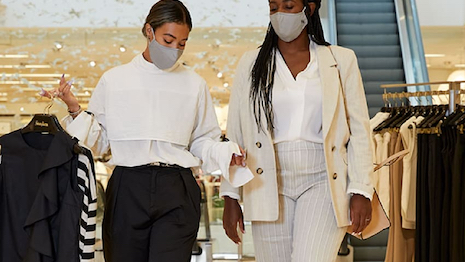In the six months since COVID-19 led to prolonged lockdowns across the globe, it is clear that the pandemic has transformed consumer behaviors, attitudes and even lifestyles.
A new report from Brandwatch examines how consumers handled life under lockdowns, as well as how they are approaching life after lockdowns.
The report is based on survey data from about 120,000 interviews across eight countries, including the United States, United Kingdom, China and France, and social data from more than 760 million social media posts across various platforms.
Lockdown life
At the start of quarantines, when restrictions were most strict, consumers embraced nostalgic hobbies or experiences to break up the monotony. Social media lit up with millions of posts about baking, bike riding, board games and family move nights.
The social simulation video game Animal Crossing: New Horizons was the most-discussed game on social media and attracted famous players, including celebrities and politicians. Luxury brands such as Valentino and Marc Jacobs capitalized on Animal Crossing’s popularity by announcing collection launches for the game (see story).
 Valentino made looks from its pre-fall 2020 collection available on Animal Crossing: New Horizons. Image credit: Valentino
Valentino made looks from its pre-fall 2020 collection available on Animal Crossing: New Horizons. Image credit: Valentino
Many consumers also reported increasing their alcohol consumption, leading to e-commerce growth for the industry out of necessity. The status spirits market has shown recent growth, and the sector is often considered recession-proof (see story).
Social conversations also centered on the sudden shift to working from home. Younger employees in particular have grown to expect hybrid or remote workplaces in the near future.
Safety was also a major concern, one that impacted how comfortable consumers felt returning to in-store shopping or restaurant dining. According to Brandwatch, shoppers have a tendency to pick stores based on how safe they felt.
The majority of retailers, including Nordstrom and Neiman Marcus, have implemented mandatory mask requirements. Other safety measures include enhanced cleaning and contactless curbside pickup.
When making in-person purchases, almost a third of respondents, 31 percent, now prefer contactless payments.
Research from the National Retail Federation and Forrester found that more than two-thirds of retailers, 67 percent, now accept some form of no-touch payment. Nearly seven in 10 retailers report no-touch payments having increased since January (see story).
 Apple Pay allows contactless payments to avoid the spread of germs. Image credit: Apple
Apple Pay allows contactless payments to avoid the spread of germs. Image credit: Apple
Apprehension persists about traveling, especially by commercial airplanes. Instead, consumers spent money earmarked for travel or entertainment on home furnishings and home improvement projects.
A decline in travel spending may also be a boon for the diamond industry, according to research from diamond company De Beers Group.
De Beers found that more than two-thirds of Americans have canceled travel plans in 2020, with 55 percent of those respondents having extra spending money as result of those cancelations. Without the ability to travel — and only 15 percent expect to travel for leisure in the next six months — one in eight respondents would opt to mark a special occasion with diamonds (see story).
How can brands adapt?
As lockdowns and restrictions lift, many consumers remain weary with 30 percent feeling “very cautious” about the future. Consumers also seem intent on keeping their slower lifestyles, rather than overbooking themselves with obligations.
This simpler approach will likely also apply during the holidays.
Survey responses and social data both indicate that gift budgets will be smaller this year. Thirty percent of survey respondents plan to focus on building, or rebuilding, their savings over the next year.
As brands and retailers begin preparing for the holiday shopping season, they must keep in mind these changes in consumer behaviors due to the pandemic.
According to Kibo Commerce’s “2020 Guide to Holiday Commerce,” retailers should focus on personalization, e-commerce and fulfillment ahead of the shopping season.
Cyber Monday has seen record sales for several years, and as consumers remain weary of in-store retail, online sales are only expected to grow even more. To be prepared, brands should take the time now to make sure e-commerce sites are easy for both retailers and shoppers to use (see story).
Retailers are also working to improve their supply chains.
The pandemic has accelerated e-commerce and many brands and retailers were caught off-guard by the surge in online fulfillment.
Sixty-five percent of consumers said they experienced out-of-stock issues during the first couple of months of the crisis, according to a report from Astound Commerce called 2020 Holiday Preparedness (see story).
{"ct":"BnazZ3mEweGnQXT4ZQkvAAT+oNPUT0JVq6lCL68lgLm5NP2i0FiP+6+mv8qI5V0dxK1e8gitHI0KsmVn1XpkAwMVvncfIjuA27qI+48M78eZGAfMM36w\/12vonA\/\/RWNQxC3N+3nTQ\/OgXQ\/LT72vAUA079be7i7Qhl9Ipgq\/XoEIpN1D+hwlzOuxWxhD6zV2TWfTIbLiBEsKyYE2wCssQb0K5VQRJoABnTlutoHTrDYHXKzQVGJuPomb+POZ4700MzUzI\/kZ8\/qfruysKEVYHTejV\/TyOZK1qHgjGKmS7pWqkHvKGuUFvAqnaYsSsxxDnxqsg4Ipp8CYXnribvzDibjiice0yTRsYE0F+J0XTchYx95HCvZjQrnJeDP\/rUpLjhmyRWULOtBcMHF5BOaC1IRtclsGmlBw\/3xjgt2o56tjilM5abqtTZ5qf7\/bQIflBYK4wSkFfZiLzwHoMe1v\/1JXvLa5OCI67djuvWnMCJd\/ychkeDjrbcYj7mUjYHZZWgGa+EU6RcWVKh+pU0szUsVloIpjypLEiBEv29VrP0VahG3XdYVRphFG8zqT8IPTaaiUIfSczS1hvdWan6rmBt2A9WaFtAllt7fdhj632Mq8id7ebtD+t7LLZkjDwvx+B6tL0jQJK9CRJcCdFGEaXmEQ7g9WPDrzifVCSUzBkjbMiQQdO58wJRJdsfxOqIn7LITxmv\/05oX91coFAZw58hIQDRCqyamJPwf3EJZfce+TZCKkthf\/RHqLmKoemkKA2QYBccUO+TTSrKlOCfc004CXomq5+aGC0G2ttd\/aBusyIjPIGg5HqPryFpWdgiC5hXFcbRBuw33CybgXFOaCuQ6bxI3k0x+8jqSBS\/NL3hIjha9FNIHJN55Rksoml60Yqm8HEU+YKQ0RriG9TeHYEf\/DFPCd\/VbVH9hX0FF7gGW860yRzCZG7tsn8ofRj3Jolqco39O3uUH4uJS\/ed5y4Bw5fVlKiADFXVtKbtUu3EabGb22lMRiZJpFLK1R3UscDHgmMD9yzFRM4BJoXNQshbxhkdL6gjV1YI7NMh91fvSMhgKgF8eXJssUtWcmUxuBB0Ka5tj0qFHKitiLcfz0K7pZ0YY6esmHDlfVR\/YAa4cX6JefMIYRer8yJRK2Tta300yaszlyqASB3+ZBcnqRH69rimdg4VLXLjN5EWFnUr6hKTOErwekLXcRRR+2kFvE+XCKuWJvnMABB7EoOQ1cCm3fcbACFj7ATdvllyQEzjaNzoJ5OqlFkof5qMFhB1Z9CUK3quAoML72EyfaRiaXTJCb1d\/UeHgJmboSNoY5H3muzDF\/KlP+CQtJ3D9UGEvfVDzQbfPOnCWe7W0xFyauxG32umESrkR+EfxP6RQIo2OWxqSVAkFhu9MRnsBTJCty\/mONPc2jrJnpACmvR72B9Lllzs0Q8DeL\/SYLHTaIi98NPoAaJJW0Js2KXLzX+EetwOBKfrD24Da8ZpedVlOjrtGYCjk6UiJFkTNISuFLWdLcm0lXvlyJQ2bGQUd3AmmYQSO8T1OImb8AdvLAY7Op+UN+wjft\/KqwscLSs5eASh1xdpDaNZFv6RqdQhD3HfvulwW6Qxmk\/6Q+CGa9U3NffbVkohH9IZRWHAY7mafKStSwDgOToT01bK9nxpqVGBS\/82YKJ4ziR9uhTLljGz42vpARUFY6qBWnCxqq2Pf2lKv1hkWe8FYiVuL9l7ImsA6+mcBOxBIcr0I5d296BYF6BsWZe+8sTj8oTbeaNLREW+PCQh1zxeUiFslxzCN38BgVjTnc\/GEGtamR9EMbNnh\/LM6DG\/88lJZx3b8TjxXSlGgYijTLKVFNxI2uE0xi0PnK\/Y0jjmhwtJCn9PKCLNQMDmP80D6shwXIwiJ28UHFYunQiMZ84a85qvV8DpJqGE8g4mvZXy0FKGnwYxn0DLL8ij1PMp65UFmfFNv26\/PxhAA3ul2gMHK3HfbaA+BFPJVpNNxwhsguL3mBNFMh5d\/6b7hWeF8aMxQdHdaNdxjXqbvc\/NDBoIb+jTR3Tyj\/s62ziy+RbkxnTkQJeAjbQtklDyu9kpZQamHcuB5+cT6FNh\/r89s7R5I\/Tcx8Vm+4fqziHacnOC\/CJVrf8miplqXoAg0j67sZ\/kPLLbI3BjsOETcgxBVs8e+3fPQrEdqHtw4CYBzMlKO\/uC+jZ0595pa\/tuLytKbyjnBMRco8hbtDLU+K7WDlWhWvWQhECCA9ZUiYUw\/9H+oQ+dt1VNUL7rVxBKW\/UMZ0W\/QEtSuKAHg8gk+wBB6k5XzaBOpkvSnnTHbdkkw8D66ahm97uHXjCSoz9JhCAPk16NdDcFRWuu5fjJJ1xvrV4O0zoOjS+mmDu2Fwv491t8MjP6JFuJ5KqMfg5zedF+WVW7PfR0+G9yrSInHyAis4NLxxILWbNYuQMQdiPBE7ylITAMJe2uDJESa\/nCYVsykKsZnK0FSrpdvi6RScCTUnsZ\/drlUTNmWI\/rebPYcTMm2VUWstgTXykr9+ETS3Mx2p96XXNwFUnMGpQjKWn2M4D4aRYPNIir9qosSCKBAbpTiExPms8SErdxtUnPtjRuBTLHDRT6AMKFXl\/vAk89pXfOMRWkmMU2BxwVQydbLnTODUkhtCRXVw9IY3X469GQwi8CH6AmQ9\/qNiV9uvV+6CnT1e2HMCKGK7OcDNHTNBQfJOs0qQldeRhSaTh9hbr1Q6cD\/YEONMnAW9OBh\/RqqCFz2GpTOdBr0YoP\/6QfSp\/K9KS9SgFUgTeGarFQCWWIsozEDYqYO4OhxjLzs+fHoEGE9S\/AN+r8\/tCwXE1GyHZ1zinbzhNcgjO9qnGUDP3OzAtO13JZhp8Y0TVLjMS4fPlZkYo+bZYnXIbuGm23POJJVvjsIjfv0f9MKIvrquIJIy\/T2f7wT5R+r4I9zhQYAdM5GZYL\/qDBKGoNZggUytTrIaYU4zcGszVKsKLZs8CsTrktOC+U+2y841uPb6dhmeVqohklJQ4tayyS9Kzer\/xonTZoyn0\/WA5ErPCRmdw7Y2hmwoc6VJ2l7ZoIQSBWyYnD0aGOvMwf4tRITXrbNIeEiXf3Kk8Skes9SNviWkGVQ+L2oRq+mceCWdRTwqL\/wz3DYdOw1urQ65VjcDzmJAFqPnvz2iCTk6Z\/NDTQCkc2BDigpLVLlMnj7pfNWgKCeqj+i6j+wiShcvJtxkLPKA2ELZVISugQVgdfVGM\/YvClEnELge1PxUKAbQDBI62pQmgKe5nmPCVjzzNAdkEiHXGeZsbtWKb7Um+eXXOl50PU9EZ7fl\/GXNFbRR9OAzxSXB3VngwdCGaRkQ+EAaPLf\/c9UujruM4Tav56JaivD7BGGyyC06H7owV\/B2I6GVwWpQqbCtBmICckNEgcBzo97bCMd8UbrfmYoCtacZW6O8Cc2XVnNipLf5sFLXHTbuPY2+rMn3wG38UUiHnjoQkks+XOD1Ck+DLoVRwDQ9rI0Vo6TNATzPf0D4UBPGGOokij9Qy3KwjwksctWpL\/FwT1I9XROUk1VP4IVxv8BRKJ64rC3cOSQF0bnhZsnKs5LbhxufwmOdFDbY\/dUtAWucumKb\/pJxCgGY1nzYlSFJW61eVdsDnJjBaZ\/SHXhk\/hvJZtfBjwj1y0KRHXp9XxX9I4XUZ1e5gXgIY5CpuxmNTnT507dSXJ2NxmEOXGuf9+hP097MxWejhCNj1TOviQgYTW74cQ3d5vFtI9tLkyiF4syryYAREf\/+kZnrmKQGG3BeELqNmwrHZLUa0gGW\/HHb4Lj6QvjOhKFC7kxjkampUrh7GDzWSpfRB5ypyBGXE8jJAG\/lD24rQTmz\/Q0Lq7oSJD4PV2A0lA7NlGvLvKufGrklTEyc+xxra0YH2UBpA3WHoO1Q5lrVIvnwTwajlBdklJzyz9uoPzwBYo\/f+oU4IN7CDNe7v0dLOTtT1hd8qvFk1l2HkX5QXo\/YRWQKu4U\/bRl\/ApjQ5dGdg7sKIZVXCcG5clQQoDzKH2nqK2j3x1nU5FBrXJYq\/cBea5Ja5hVghYiCQJXJhNsYQNEd\/S1vgYiMAEnk2KbWpMjjTHPXcvXn0YYZnjjF5wEbfCCY\/91OZN8bhfqTv64GFrT6YWgqEIHMvp\/ZUaqRg2Ih6Ggk1o3dYe61ZK7F9YIbof6ijyiM15cTW1n31yqrJ4wdisYJEmXsBOz+9KW6h\/NJRs9nFSnWtMScXsXyfYu9ttw0jq27VqRpZphrJfQfCa8nOQ3B\/VI4Qu7mQiVWfbWNhF4J4oCE35wRB8Y4DXCPz4zpFDTEmMIQ5COxwr\/ANKf8sjIfQGIkZJe1x7sykzNSYcKuT2g9pSqfNNP7pFZ4yugtHdkbsw+cjT6khXZGymaLtIn1eXiTB7fjK2fxw2UKJzR43hTxDkzN0kez4H9gcL+6t7p54wOsqnM6gtynJyJq43DgQQTPcx6E\/uhK9hry0DilZanS7AM6vXf3dlTKBlz1sbR2AfC5rvL7Kp8SNeNuMyvAtJCunYRNz55lMou0AWIXC+UzuGacjMWESJepqxby9EEOyxpZpAls+QoiZcIqGu8V1ZWGtlb537QQJs34GFCcoFCh\/Kb8I2sKmJo3BFxjX1JiZLqk55+8oKMwRKB4XDDK69YnKgEv5qqHXIPScVfVwW6mfnLTUrdw7tXyOnA7RHLFayZjJ2KTprL8Es+GXFX0Jx3X3Ik1I08SlJf0opuJybc0kRfv80TWn3zfzsVA3UxFukBXSyX4mkgQVBCK3+yZ7YgMJyZatVvPtHPIiH1fGtI6lirU7awYgjXjhXYoFO44ewZZzEvCVslTvJ43wMVabsLbDRCM9fo2FDt+hUMLTYekAqcblE6FzvEZ3n6dwAK\/nkzyvhOGKEofhSKJ6T0+h+42y\/8iZOfWG7o4lOt7tvEezMy8s2k3dlz\/6M79cesLEacwpSbB5vO6RdzCd3SL+nAJw5rkOG5JRnUoZcyaMgtpdH2oYcuCq6fFtF6a\/nT8e9QB15DWDxxWmmOCHNVcIUcARxURMhWavYpIhHl5LD5n\/BNpSUaN+QSWhJ97BNhx1fBSmQT66haC1wIBvfKVAEtBtb0K4GOHD8P62g39PXoEZX33ededafzJu3\/EqUDIyP0E2m4aecGwjFXL2yXM4HuEdEb3QULloEipXq0ShNrT2Tm0CnIKokgfxc3EaZr+GsudB6ly6OW1jGvHQTbs235aMYgms7VSw1oxHccd7ORWNS3MbAQbUlGCeTLItKF3dfZbvH40kpivqgk+Mhv6spC5pCnXb\/BYl15npzJuEMaEnLrIBs4bMNmbgWtmXwzuPIURhs4gkqkRyOvTKDMahAn5kfm3nRYjC6NDVBBDUBr8AGVnjE9jYc9q4oJCCF8jYUS0zH8Qnlx4SY3Pi9NmknzX9cNHQXJweJxyYxBhb\/ouiULtBx7bZcSw8NgIdQIIZ8kb1U5pQK9q8NPM8PW1N5Yt4cCVV9N+Qhu+t9W3GauvrPNrmzu5h05zk5gXmV0nfveNeUENDB1ohk5aIYXfIbENhwIfDRHKLZzmrbET\/e\/UiBJ9E9JJeeRrufsr67R81Ns1vvCtD9a6zudV2s9K939QzHIKBWPPHnC8cLNl4mJdcAT3K6dSopqwjF5a5bAl6AtcfBNsuUbJapkXlxt\/1yy3ixkMBDPA3PWJgpHzkfHMZo+zVgfqkEHZGrIo0yscMfJeFRkp3oG3KMWFXXRVfjK7R8aeJfzF0rzlsdZF41diTU6LUaBUA3nuLeBhMTe3bBO8esyACLhANEgO0P+2yb5+4qBIMwRXAQae1RFqs1h+u4tL0dMVE+ZUyhe3iQ3CfFtVtraD\/BaGxviav11Wf\/LZiAM\/41Ejxo8A0GS4BRQO3TBVvl+4NsIh1KJjjFOAMRhrcU4y3vG4qmIwKPic5tVl1LCgvnu08RPftstwSc3ydsB8nAfRmDfAAt4wzHwyrkV1JIhkQmD6d3Ms3A7F2sgcaSfFst\/uqNN1rOZpNTM1JumTas30Hh4XcxYVaPv3lOsM1ZntbSFedDUYPud38MioWLOnQZnFhmyjtdogcBxx2veAoNBkjrB1Qj5Ow8jrHdeTP6ivGoITfMxySI9Gd67zHjaFPZ+kBuSSFxe9MeitDH7bZSWbKvT8cF76UkE\/yThCxN8a+YDbxZy06XnQM4m\/dnIK7FalEy0c1rNLWSImzkwKnraGbvfnvLqy846I11hawGSAyqqcmZphESn+LjdcO3nV54c88EVL9\/XpqMth+k78VWVVsC22d86wAIPx2xsF3EAfCxEMbvPI+mpPYevadoFtTfPQ7WENNBPw\/w2tRMZz8PdCpU2CbqhDReSN062uSODCBauHOyzfLgKsKBEPt9lzXoMURhhFdOab7TzBiK79Z4YJ\/74aNl953MvjdTSpylBk8sgRMp9zBhIqcr3g60zP3SVDa1y2oXn6zKg82NGhfYA8YI+hHc73Ds6i28GgLj+C+WPiPIk74bKkXm4OfsABfAtmhrgFHwAGVjZBJTpOBmUX5cxTM9jpjdtCrnxtRe4QyE2YI5rymI+ltJSCkbA9IAjNgoPYcpNUFSvjiVOerSbDRRXaFZMK1L+iJ7vGLqCkMtoEhTLRTV2b+V5cTYsGIcgyqz3Om+aQ88ShD2xOt2ah1fQTH1UKKUfgaq3r1Ah0acz69LPnI7k+rhqSEXToYS5WkMyyvARdggF9erV7eju4R43M7HEB2RuMN1UFTqWej\/XlxruxzQrl3ioMrO4B1T0xpTSil5wfYb\/+CQFrwH3bibY1+RSxShQHUFT+Bgq6Riu3UpXhs7m7XN3oYAqaG9iak5nEldIvVkE4+Ll+YtN56AY9MbFy8iDZc3tJVcKeZeMESZr9nEcESGPtZ7IYPEUPy0Ot+2E\/kyIihHdICwC+qOp8K+tmLTTqAFUtGEfAyikKzJY9\/4tIBFk\/0Xj94DdiDrsmMKmpwYDeqj\/G9BAN0jYpOP4vz7LISF5v0BstB7G9Eok\/kr4kPTgxW+ZtQNC\/\/md5uCS93xpJFH9veLBwzS3hpY6gZaLlEVtKI1LU1vRKOnrYxAb+IWLhNrDRzPESE+zgbtFt9wmq+A8xU4BdckqwfPptoBofMqUFSjT36hIK5jn0x1YQwIJzjR5sLiiHhDvhI9PjPrYrPCgyRaC+KC893yaWxVRsFNNvtzliiUxGxvkjBSoHnMg0jsPgfao1CSla5Ty0dnbp9woczi34HZHpj72836CwYlYht+6B0FS9i46GOXsi1J0D6eKfauhbBjsKrhn2+N1RTV96JmShUZ+jPwedmrx1g9LgQ5Ok2pXfclMLJoTJInWE\/bnnM14zz8tb9qT1vExYWVVqX+XLeL1LPX4\/JEesIAjxz9TYsW73nFRwjQlnQIcFvNQz23WslSVWrNvnnT4NjjWncHR6xPOAA2D\/\/3TQITW6NQWzSfdL4XvbaYQn749oGyMRB77juM3eBq8tdgii5Lnh\/K\/NibMK93YbXGW+xeakLlMno4jzP9XwltStY8RWAT2xphci+Wb7JQpZGYGvUzUZhgyzw7s\/jq4ZT29tVeYH+BhNrMKs1PiH4\/RTfGJjHtyyvZ31ydlBSVuH\/oAchHEcKSiOAcmCtAc3ezolI5DEJQ5JeOXYmWzMhw4DzsGpi92u5EdW3JlSujCbIIxiFir5glcLlkUeBdlVPHCOCzuaulfGq9Mh\/zyy4Akl48E81rZVcBZOhf3XOxOIxunQIIxQJ7XVf2WE5YmHaDpYnGxXcW\/p63Xc9dLbRFNN9cp614LuzpuHlfQHXqUK623gkpPfuoN2NW0iqXLy4x7Mb5uN6QPE1S2PCNY1+yFVCwKO+ymUBH0opGdRZP+7NvFqaccHYUeYVr+T8CRzREA32dJmFBsbOkPj7W7oIjrzzCi03BLX2J1VKosEB9U0uSQhfdeg8KANgw\/MgdUthQlYkGFmrdTSQLyMNEuS8AIXd7n+S7IrupS5nL+x1uCIwH0ysSACt90dLXigfoT48YEc8Rh8GmTFW5DPFAaI0G2TaUpBtPW39Ti3sGVirhbuHZUGjPAX4YA3EfiMJpJOBqpDajdHsF3yFqd1Qm8c0U8aAyUsFxfrSfoyNkA05IMZVBU6Q34kmV19jv6q611kHepX4t2KsUmutcRU2FrsxQHiZKS2u0gNrM26EYkID47hR4S3+kKEOXR9vqFAE8tyE2TXsx5K1f7obG6NNrvS+SWEbp3ObasFL0PA7\/QTO02vdt\/vaiCubQccEpWly15wYqerjGy9yTT+yA785QOyFLRfW0q11FXd6W2McZ5cSyPnl56m1xtDOtMnFEwKz4a0IvUxmbfUx8uDYoVdgNtXfsM4OH+W7v+bjkWJh87vOXWQsKIDtabt5ZW1JJ4d7Ql5C7Q8DncBhEvlNCVu0q5NlBN2qICIuFR0Qf0oAYFuwD3Wu87qw4RHMZZvffFpJWFycfp51\/L\/7FZSHs5tbpTUgF27TLDvfHbivRoiUqqj2n9WY92QlxdDdLKr65nURU19hPCbi1W3mdxVJiFZJM44Qs0DhgdfCYoRD3eAu2fvofXulJ4yygi1D7kAPlrvXhlEB5uLfSnT87bewr9l2kPg5koaOYVCpU5iDVeBEmCVcr7gXekm41oTVmCbo1eERPEhS3sNUvfKCHLnzOaF8ZT26E8lNA5ZD6+pjeqGPJEdvLxFg2xhmZl8WwjmNKpquFL9C99GSsUuYK1B4BHLqFJsTjX9kE+3ZPlk6MU0m2edwcUB2Z7qqnDeS4ThbyRCSWBtqvkEfxqcxZAj+t27ekiIpiQNaun3KBbAaNp7FDPjo3uf13GH3ugeoc\/3yzdC2gxkkjDxbcmO4g9V4yPhThEU8LxJVcr6PYnV2dSriZi5W8W+ZGr4RVpV89637FHwjefKghOJpHkRHMzULEoH+YwJzDmhJzMcnLc9BtpbDK\/3hdm5k25Xp8K5R8Ptnj6E+AUF5YpAoNmFQcrWbu5pRFzhtuYtJExjoduL6IB1Hq4pzZjASvizNuVzVlMfcfcSWZmbuOMhmLbxdlxT2SyQjEIcFdK9ejZK2AcghyTvLME2IoYO2DHZyvEah7IPyoSKLnAodzTB6vYX6+sH8HfmE1g2\/Ig9LuYhxHBz7uk9HcIb4gn72Gg4nbBGXafhG2EI34t6DmAT5l3W3Bu6cCYK1iUrpmc70hKVqHRzwnfPspGwuKWUXOEbfkkV0OuUGRKuOJ4z3xz","iv":"cb908cfb3b7d6d35b45cf11c9fd2b95d","s":"da64abd93ed38063"}

 Shoppers and staff are required to wear face masks in Neiman Marcus stores. Image credit: Neiman Marcus
Shoppers and staff are required to wear face masks in Neiman Marcus stores. Image credit: Neiman Marcus
 Valentino made looks from its pre-fall 2020 collection available on Animal Crossing: New Horizons. Image credit: Valentino
Valentino made looks from its pre-fall 2020 collection available on Animal Crossing: New Horizons. Image credit: Valentino Apple Pay allows contactless payments to avoid the spread of germs. Image credit: Apple
Apple Pay allows contactless payments to avoid the spread of germs. Image credit: Apple